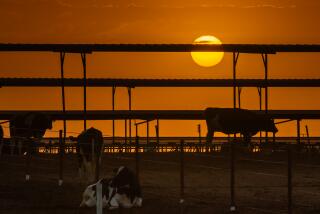Beef Up Livestock Rules
- Share via
In 1996, Britain’s health minister admitted that the invariably fatal human variant of “mad cow” disease had afflicted the brains of several British teenagers and young adults. That was a point at which Congress and U.S. Agriculture Department officials could have aggressively implemented safety measures to protect America’s meat supply against contamination. Another obvious point was in May, when Canada reported finding a single infected cow and suffered billions of dollars in lost trade as scores of nations banned its beef for months.
Now that a case of mad cow, technically known as bovine spongiform encephalopathy, has been reported in the United States, Agriculture officials have hinted that they will soon require destruction of any cattle even remotely connected to the infection. That is pathetically too little.
At a minimum, Agriculture Secretary Ann M. Veneman should require the livestock and meat processing industries to adopt stringent safety rules that mad cow disease experts have been urging since 1996:
* Prohibit the feeding of meat and bone meal from cattle to any other livestock. Although the U.S. bans the feeding of meat and bone meal from cattle to other cattle -- the suspected route in the spread of the disease -- it permits cheap animal protein to be fed to other livestock. On farms, however, feeds for different animals are often not rigorously separated and contamination results. Agriculture officials in the Bush administration have argued, as did Clinton officials, that the cost of more regulation would be prohibitive. Now economically devastating foreign embargoes of U.S. beef and fears among domestic consumers will do far more harm to an industry that employs 1 million people.
* Begin far more rigorous testing and tracking of meat and dairy cows. Although 37 million cows were slaughtered in the United States last year, only 20,000 were tested for mad cow disease, fewer than France tests each month. Additionally, no beef brains or spinal columns, chief harborers of the disease, should be sold for food.
* Ban the processing of any “downed,” or nonambulatory, animals for human consumption. Studies in Europe revealed that downed cows provided a major pathway for the spread of mad cow disease.
Mad cow disease evokes a fear that has no relationship to statistical risk. It is too late to undo the harm that a single sick cow has caused. But it is possible for the USDA and Congress to restore confidence in U.S. beef by dropping the “perhaps” and “maybe” from statements about firmer regulation.
More to Read
Sign up for Essential California
The most important California stories and recommendations in your inbox every morning.
You may occasionally receive promotional content from the Los Angeles Times.













